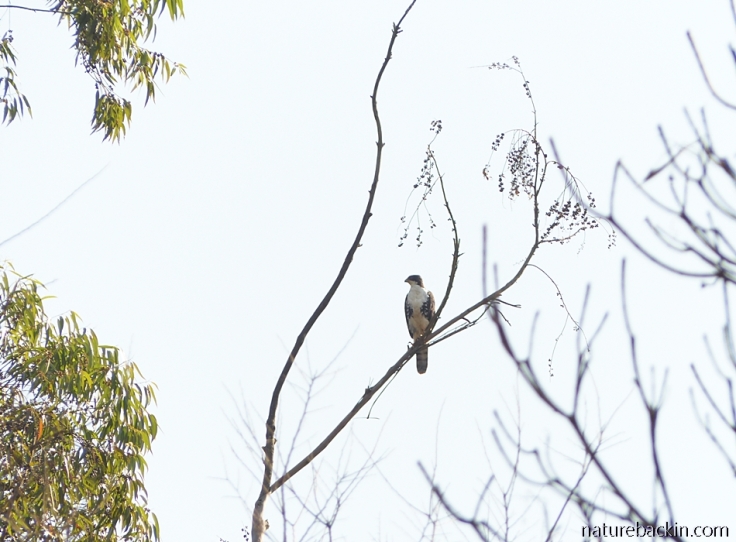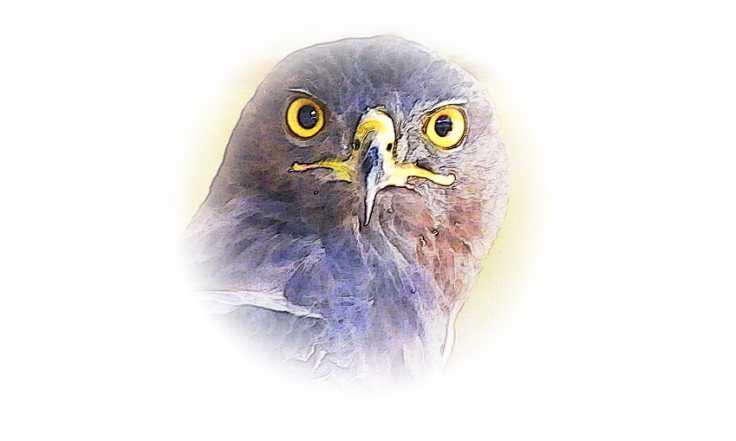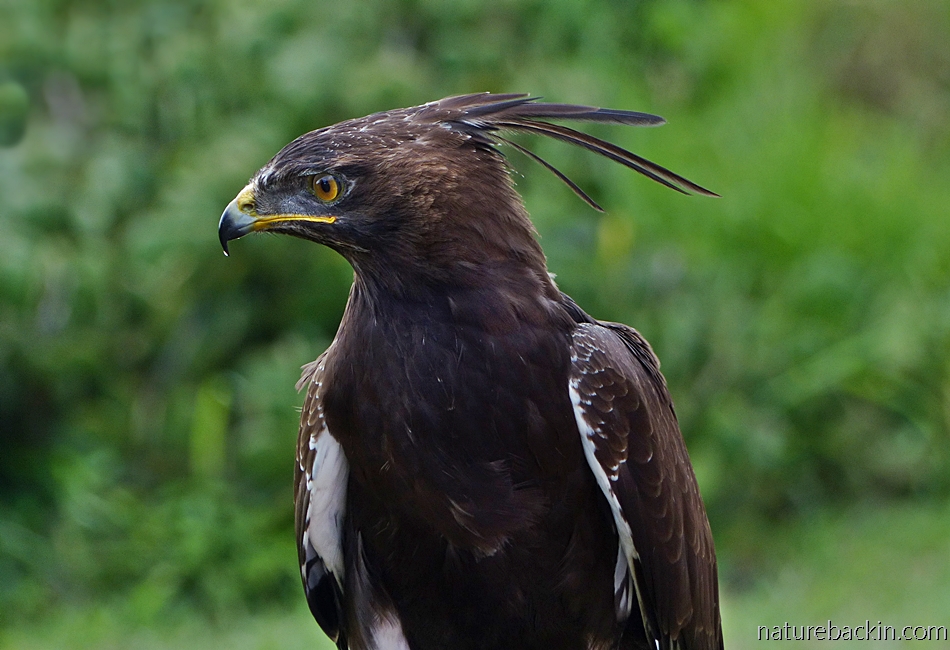It can be surprising to see raptors surviving in urban areas, but in circumstances where persecution is within limits and prey, shelter and nesting sites are sufficient, a number of species have adapted to living in close proximity to humans and built-up areas.
In our neighbourhood we have resident and even breeding pairs of several species of raptor, as well as occasional visitors to the garden or glimpses of birds soaring overhead, such as the African fish eagle alerting us to its presence high above with its iconic call.
Although long-crested eagles are commonly seen on the edges of urban areas (as well as in farmlands, conservancies and protected nature reserves) it is only recently that a pair of long-crested eagles appear to have taken up residence in our suburban space.

In South Africa in the eastern regions, solitary long-crested eagles are often sighted conspicuously perched on poles near roadways, both in suburban areas and in the countryside. These eagles also occur in much of Africa south of the Sahara
The long-crested eagle (Lophaetus occipitalis) regularly uses the same perches – such as trees or posts – in its territory from where it scans for prey. Once potential prey is spotted the eagle glides down from its perch to catch its quarry on the ground.
The long-crested eagle favours living on forest margins or in woodland and has adapted also to exotic plantations, preferably adjacent to grasslands, wetlands, marshes or rivers. Preferred prey animals are rodents, especially vlei rats. It less often eats reptiles, frogs and invertebrates, and more rarely birds. It has also been known to eat fruit, such as wild figs and mulberries. Because of its large gape, long-crested eagles can swallow most prey whole. Prey animals too large for swallowing in one piece are dismembered.
These slender eagles can be quite vocal especially when in flight, and it is the call that often alerts us to their presence. Despite them calling in flight, they can be hard to spot from our garden and even harder to photograph.

Although screened by intervening vegetation, the distinctive long crest makes this long-crested eagle unmistakable as it perches in an old eucalyptus tree on the edge of the plantation visible from our garden

I photographed this long-crested eagle soaring overhead from our garden. The white windows near the wing tips are diagnostic. Most depictions of this eagle in flight show the tail spread and revealing the white barring on the tail, but this bird is flying fast with the tail feathers held together and streamlined
As I have seen a pair of long-crested eagles hanging out together in the neighbourhood I am assuming they are a breeding pair, but I have no idea where they might be nesting. The female is usually larger than the male and has darker legs – the males tend to have very white legs. Long-crested eagles form monogamous pairs and they share building their platform-style nests that are lined with green leaves. Tall eucalyptus trees make appropriate nesting trees. A pair may use the same nest consecutively each breeding season for as long as five years. Alternatively, they may alternate between two nesting sites.

Lacking a decent photo taken from our garden, I feature this photo of a long-crested eagle that I took at Tala Private Game Reserve, near Pietermaritzburg. In this photo the slender build of the eagle and his white ‘leggings’ are evident
Long-crested eagles lay between 1 and 2 eggs in a clutch with with an interval as long as several days between each egg that is laid. Despite the resulting size difference there is little aggression between chicks. The parents share raising the young although the female does most of the egg incubation duties.
Threats to the nestlings and causes of failure to successfully raise nestlings include “strong winds blowing down nest or injuring chicks, fire, disturbance caused by timber felling, predation of eggs, probably by genets (Genetta spp), predation of nestlings by monkeys (Cercopithecus spp), and harassment by black sparrowhawks” (Roberts).
Some years ago, we used to have black sparrowhawks nesting nearby our garden. Although since their departure a female turns up each year at the start of the breeding season and we hear her calling, she has not found a mate or nested near enough for us to be aware of her success. I have previously documented the sad departure of our breeding pair of black sparrowhawks, which was largely due to the felling of mature eucalyptus trees on the margins of the plantation, even though I managed to save the actual nesting tree from being felled – and it is still standing. But I am wondering if the gap left by the black sparrowhawks is partly what enabled the long-crested eagles to move into the neighbourhood.

A photo I took during a visit in late July last year by a black sparrowhawk. We think this is likely to be the returning female who used to nest nearby every year for six years. Although she appears each year at this time and calls repeatedly from her favourite perching tree, she has not stayed to breed since her departure after tree felling in the area several years ago. (Average longevity is estimated to be 4 to 5 years, but one female in the Cape Peninsula lived at least 12 years.)
The long-crested eagles, although vocal, are much more of a discreet presence than the nesting black sparrowhawks were. They are in the company of other raptors that we see regularly in the area, including African harrier hawks (gymnogenes) and crowned eagles (to be the subject of a future post). Other raptors that are around but are less often seen because of their more unobtrusive habits include the African goshawk and other small raptors (which I have not yet identified), as well as others that we mostly see passing by on the wing, including yellow billed kites and jackal buzzards (more recently since parts of the plantation were cut down temporarily opening up grassland-like spaces). And there are also resident nocturnal raptors in the form of owls, most notably wood owls and Cape eagle owls.
The photo that is at the head of this post is of a long-crested eagle at the African Bird of Prey Sanctuary near Pietermaritzburg. This bird was brought to the centre when it was already too imprinted on humans to be rehabilitated back into the wild. It now lives at the centre and participates in displays of free-flying birds that educate the public on the role of raptors and the importance of their conservation. In addition to it advocating for raptors and their protection, the centre is also involved in research and breeding projects and works in close collaboration with Raptor Rescue, a specialist rehabilitation unit treating orphaned, sick and injured birds of prey.
 References: Roberts VII Multimedia PC Edition. 1997-2016 Southern African Birding. For details go to http://www.sabirding.co.za/roberts7/portal.html
References: Roberts VII Multimedia PC Edition. 1997-2016 Southern African Birding. For details go to http://www.sabirding.co.za/roberts7/portal.html
Posted by Carol









July 19, 2020 at 7:08 am
Makes you realise how important it is for farmers to leave trees bordering their farmlands . Both to create nesting sites and to help with rodents
LikeLiked by 1 person
July 20, 2020 at 5:53 pm
Thanks – yes very good points. I hope more farmers are realising that raptors can be so beneficial in things like rodent control as you mention.
LikeLike
February 24, 2020 at 11:31 am
Thanks Carol for this informative column Carol. Never seen one here in the Cape.
LikeLike
February 11, 2020 at 6:50 am
Simply wonderful Carol! I love reading your blogs, so much information and so thoughtfully composed with your stunning photos! xxx
LikeLiked by 1 person
February 13, 2020 at 7:30 pm
Thanks so much Christeen – I really appreciate your kind comment 🙂
LikeLiked by 1 person
February 11, 2020 at 2:52 am
What a gorgeous bird. Great photos and info, Carol.
LikeLiked by 1 person
February 13, 2020 at 7:24 pm
Thank you Jane. It truly is a gorgeous-looking bird.
LikeLiked by 1 person
February 10, 2020 at 2:44 pm
Beautiful birds and great images
LikeLiked by 1 person
February 10, 2020 at 7:14 pm
Thanks very much.
LikeLiked by 1 person
February 9, 2020 at 10:02 pm
What a beautiful eagle! Bald eagles are making a comeback here in Massachusetts, and they are handsome, but I love headgear on yours!
LikeLiked by 1 person
February 7, 2020 at 8:11 am
Again I am awed by your observations and photographs
LikeLiked by 1 person
February 7, 2020 at 7:13 pm
Thanks Mariss 🙂
LikeLike
February 7, 2020 at 6:55 am
Wow. How fun to have eagles so close by. I have a vivid memory of a pair of bald eagles setting down on branches at the edge of a wood where I lived in Washington State. I figured that when they left they’d come out the way they went in, but instead they disappeared farther into the wood to the sound of branches breaking left, right ,and center, as they departed!
LikeLiked by 1 person
February 7, 2020 at 7:13 pm
What a surprising departure route for the bald eagles – seems they had a lot of confidence in their own strength.
LikeLiked by 1 person
February 8, 2020 at 5:25 am
There certainly did!
LikeLiked by 1 person
February 7, 2020 at 6:13 am
My son and I always look out for the Long crested eagle which is always perched on the same telephone pole as we drive past in the mornings on the way to his school. Love his distinctive crowning feathers. Thanks for the info and gorgeous pics!
LikeLiked by 1 person
February 7, 2020 at 7:11 pm
Thanks Carol. How nice to see this handsome bird on the way to school!
LikeLiked by 1 person
February 7, 2020 at 5:27 am
What a striking looking bird. And an interesting neighbour. Here, the red kite was reintroduced to a site some twenty miles away, maybe 10 years ago now. They’ve thrived, and within about six years were a common sight over Harrogate, a town some 10 miles distant. Farmers aren’t keen however. We were so excited to have several sightings of one over our village last year. Which suddenly stopped. Maybe this year…
LikeLiked by 1 person
February 7, 2020 at 7:11 pm
I just looked up your red kites and see that they mostly eat small mammals and carrion, and that could be beneficial to farmers. So what is it the farmers aren’t keen on? Perhaps they fear that they might take game birds sometimes? Anyway, its good to know the kites are able to live again in some of their former ranges, and I hope you see them again this year.
LikeLiked by 1 person
February 8, 2020 at 9:23 am
Exactly, Carol. It seems that raptor = bad. But generally, they’re doing very well, so there is hope.
LikeLiked by 1 person
February 8, 2020 at 10:12 am
Hopeful indeed.
LikeLiked by 1 person
February 7, 2020 at 2:51 am
More proof that humans actually can live in harmony with nature if we give it more effort. Having raptors like long-crested eagle, crowned eagles and gymnogenes part of the urban ecosystem makes it healthier for all of us (though maltese poodle-owners might disagree)
LikeLiked by 1 person
February 7, 2020 at 7:06 pm
It is great when urban wildlife gains a level of acceptance and even respect, and raptors have a role to play in controlling numbers of rodents and other species. Although it is thought that it is only juvenile crowned eagles that take pets occasionally, it is nevertheless heartbreaking for the pet owners when it their beloved pet that is taken.
LikeLiked by 1 person
February 6, 2020 at 11:29 pm
Hello Carol,
It must really be something to see these raptors in “city streets.” They are such striking, beautiful birds, and I love the crowning feathers too. A wonderful series, as always!
Best wishes,
Takami
LikeLiked by 1 person
February 7, 2020 at 7:01 pm
It is a thrill to see them on the outskirts of urban areas and along country roadways but they have not made it into actual inner city streets as far as I know (although there are some raptor species in some cities that have). They are indeed very striking birds and I never tire of seeing them. Thanks and best wishes to you too Takami.
LikeLiked by 1 person
February 6, 2020 at 8:58 pm
Such a handsome bird! In light of increased habitat destruction, I suppose we should be glad that some species are adapting to live near humans.
LikeLiked by 1 person
February 7, 2020 at 6:55 pm
Yes I think so too – those species that are more adaptable stand more of a chance of surviving habitat destruction than absolute specialists.
LikeLiked by 1 person
February 6, 2020 at 8:49 pm
What a fabulous creature – it looks almost pre-historic. How amazing to have them as ‘local’ birds. You mentioned it may be that they are filling a niche left by Black Sparrowhawks, but were they scouting for new territory because their own natural habitat is diminishing or are they simply learning to exploit human resources?
LikeLiked by 1 person
February 7, 2020 at 6:53 pm
I see what you mean about it looking almost prehistoric. That is a good question that it found that space – although it took about two years since the sparrowhawks stopped breeding here. I don’t have an answer as can only speculate, but they are an eagle that has adapted to utilize exotic plantations even when they are near to built-up areas, and using these plantations does compensate to a certain extent for their natural habitat diminishing.
LikeLiked by 1 person
February 6, 2020 at 7:33 pm
WHAT a beauty! I occasionally see one on the outskirts of town – and feel privileged when I do.
LikeLiked by 1 person
February 7, 2020 at 6:48 pm
I agree – they are always special to see.
LikeLike
February 6, 2020 at 7:24 pm
Hawks have become more frequent in suburban areas here, especially in the winter when there is snow cover, as they find they can harvest birds from backyard feeders.
LikeLiked by 1 person
February 6, 2020 at 7:25 pm
It is interesting how food sources like bird feeders can shift dynamics.
LikeLike
February 6, 2020 at 9:55 pm
That is true.
LikeLiked by 1 person